最新初中英语语法说课稿
初三英语unit3语法说课稿

初三英语unit3语法说课稿在初三英语Unit 3的语法教学中,我们将重点介绍和练习几种基本的英语时态,包括现在进行时、一般现在时和一般过去时。
以下是说课稿的主要内容:一、教学目标1. 知识目标:学生能够理解并掌握现在进行时、一般现在时和一般过去时的构成和用法。
2. 能力目标:学生能够正确使用这些时态来描述正在进行的动作、日常习惯和过去发生的事情。
3. 情感目标:通过实际应用,激发学生学习英语语法的兴趣,增强语言运用的自信心。
二、教学重点1. 现在进行时的构成:be动词 + 动词的现在分词形式。
2. 一般现在时的构成:主语 + 动词原形/动词的第三人称单数形式。
3. 一般过去时的构成:主语 + 动词的过去式。
三、教学难点1. 现在进行时的用法,特别是在描述正在进行的动作时的语境判断。
2. 一般现在时与一般过去时的区别,尤其是在描述习惯性动作和过去特定时间发生的事情时。
四、教学方法1. 直观教学法:通过图片、动作演示等方式,帮助学生直观理解时态的用法。
2. 对比教学法:将三种时态进行对比,让学生通过比较加深理解。
3. 任务型教学法:设计相关任务,如角色扮演、故事叙述等,让学生在实际使用中掌握时态。
五、教学过程1. 导入:通过提问学生的日常活动,引出现在进行时的概念。
2. 呈现:展示现在进行时、一般现在时和一般过去时的例句,解释其结构和用法。
3. 操练:通过填空、转换句子等形式,让学生练习时态的运用。
4. 应用:让学生用所学时态描述自己的日常生活或编写小故事。
5. 总结:回顾本课所学的时态,强调其重要性和正确使用的方法。
六、作业布置1. 完成课后练习题,加深对时态的理解和应用。
2. 准备一个简短的口头报告,使用所学时态描述一个过去的经历。
七、板书设计- 现在进行时:am/is/are + V-ing- 一般现在时:S + V/V-s- 一般过去时:S + V-ed通过本课的学习,学生将能够更加熟练地运用英语时态,为进一步的英语学习打下坚实的基础。
仁爱版初中初三英语上册《语法》说课稿

仁爱版初中初三英语上册《语法》说课稿一、教材分析本节课所使用的教材是《仁爱版初中初三英语上册》,在本册教材的内容中,语法部分占据着非常重要的位置。
通过学习语法,学生可以建立对英语语言结构的基本认识,从而提高他们的英语表达能力。
二、教学目标1. 知识目标•了解不同语法知识的基本概念和用法;•掌握一些常用的语法规则和结构;•能够正确地运用语法知识进行句子的构建和变换。
2. 能力目标•培养学生的语言分析和处理能力;•培养学生的语法运用能力;•增强学生的英语交流和表达能力。
3. 情感目标通过本节课的学习,让学生明白语法是学习英语的基础,培养他们对语法规则的兴趣和认识,养成良好的学习习惯和自主学习的能力。
三、教学重难点1. 教学重点让学生掌握基本的英语语法知识并能够运用到实际交流中。
2. 教学难点如何通过简单明了的方式教授语法知识,让学生感兴趣并能够理解并运用到写作和口语中。
四、教学过程1. 导入在导入环节中,可以通过一段有趣的故事或问题引起学生的兴趣。
例如,可以通过一个小故事说课:关于动词时态的故事:在一个小镇的动物园里,动物们都过着快乐的生活。
有一天,一只可爱的小猪跑到了动物园里。
小猪取名为Tom,他非常喜欢和其他动物们一起玩耍。
但是有一天,Tom生病了,他躺在床上无法出去玩耍了,所以他想出一个办法,他学会了利用不同的动词时态来告诉其他动物他曾经做什么。
让我们一起来听听Tom的故事。
2. 学习在学习环节中,可以使用多媒体工具或黑板进行语法知识的介绍和讲解。
可以结合教材中的相关课文和例句进行讲解,让学生了解不同语法规则和结构的用法。
例如,我们可以依次讲解下列内容:- 时态•简单现在时:表示经常性、习惯性的动作或真理。
•现在进行时:表示当前正在发生的动作。
•简单过去时:表示已经发生过、或者过去的动作和状态。
•过去进行时:表示过去某一时刻正在进行的动作。
•简单将来时:表示将要发生的动作或事件。
- 被动语态•被动语态的构成和用法•主动语态与被动语态的对比- 条件句•零条件句•一般条件句•真实条件句•虚拟条件句3. 实践在实践环节中,学生可以通过教材中的相关练习进行巩固和实践,也可以进行一些教师设计的练习和活动。
初中英语全英说课稿优秀9篇
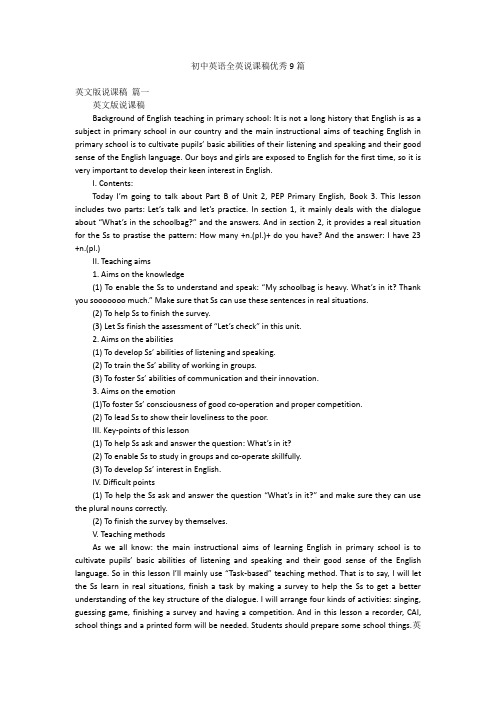
初中英语全英说课稿优秀9篇英文版说课稿篇一英文版说课稿Background of English teaching in primary school: It is not a long history that English is as a subject in primary school in our country and the main instructional aims of teaching English in primary school is to cultivate pupils’ basic abilities of their listening and speaking and their good sense of the English language. Our boys and girls are exposed to English for the first time, so it is very important to develop their keen interest in English.I. Contents:Today I’m going to talk about Part B of Unit 2, PEP Primary English, Book 3. This lesson includes two parts: Let’s talk and let’s practice. In section 1, it mainly deals with the dialogue about “What’s in the schoolbag?” and the answers. And in section 2, it provides a real situation for the Ss to prastise the pattern: How many +n.(pl.)+ do you have? And the answer: I have 23 +n.(pl.)II. Teaching aims1. Aims on the knowledge(1) To enable the Ss to understand and speak: “My schoolbag is heavy. What’s in it? Thank you sooooooo much.” Make sure that Ss can use these sentences in real situations.(2) To help Ss to finish the survey.(3) Let Ss finish the assessment of “Let’s check” in this unit.2. Aims on the abilities(1) To develop Ss’ abilities of listening and speaking.(2) To train the Ss’ ability of working in groups.(3) To foster Ss’ abilities of communication and their innovation.3. Aims on the emotion(1)To foster Ss’ consciousness of good co-operation and proper competition.(2) To lead Ss to show their loveliness to the poor.III. Key-points of this lesson(1) To help Ss ask and answer the question: What’s in it?(2) To enable Ss to study in groups and co-operate skillfully.(3) To develop Ss’ interest in English.IV. Difficult points(1) To help the Ss ask and answer the question “What’s in it?” and make sure they can use the plural nouns correctly.(2) To finish the survey by themselves.V. Teaching methodsAs we all know: the main instructional aims of learning English in primary school is to cultivate pupils’ basic abilities of listening and speaking and their good sense of the English language. So in this lesson I’ll mainly use “Task-based” teaching method. That is to say, I will let the Ss learn in real situations, finish a task by making a survey to help the Ss to get a better understanding of the key structure of the dialogue. I will arrange four kinds of activities: singing, guessing game, finishing a survey and having a competition. And in this lesson a recorder, CAI, school things and a printed form will be needed. Students should prepare some school things.英文版英语说课稿VI. Teaching procedures and purposes of my designing.I’ll finish this lesson in five steps.Step 1. Warm-up and preview1. Free talk between T and Ss about things in the classroom.2. Sing the song together: Books and pencils.3. Do some TPR, for example: Show me your English book. Show me your crayon.4. Review the numbers by asking: “How many crayons do you have?”Purpose: It is important to form a better English learning surrounding for the Ss by singing and doing some total physical response and at the same time it provides situations to review learned knowledge for the next step.Step 2. PresentationNow I’ll mainly talk about this step.1. Present the pattern: “My schoolbag is heavy.” “What’s in it?.”(1) Show a bag and say: “Look! I have a bag.” Carry it and say: “Oh, it is heavy. My schoolbag is heavy.” Help the Ss understand the meaning with the help of my body language. Then lead the Ss to read the sentence. Make sure they can say it correctly.(2) T: My schoolbag is heavy.Open the bag and say: “What’s in it? What’s in my schoolbag?”Take out a Chinese book. Then do the action again. Let the Ss read the sentence.2. Play a guessing game. Divide the whole class into four groups to have a competition.Let them guess: What’s in the bag? How many? Purpose: To present the key structures one by one is much easier for the Ss to learn and grasp the meanings. Proper competition can arouse the Ss’ interest in English learning.3. With the help of the CAI to present the dialogue. Set a situation to help Ss understand: Two Ss are coming. One girl is carrying a heavy bag on her back. They are talking.Girl: My schoolbag is heavy.Boy: What’s in it?Girl: 20 story-books, 32 pencil, 9 rulers, 12 crayons and 30 picture-books. Etc.Boy: What will you do?Girl: They are for the poor.Boy: Great! I’ll bring some school things too.The boy comes back home and puts a lot of things into the bag. Then he goes to school again and gives them to a teacher. While he is taking them out, he is counting the numbers of all things. The teacher says: Thank you soooooooo much.4. Mention that we should take care of the poor.5. Play the cassette. Let the Ss listen and imitate the dialogue.Pay attention to their pronunciation and intonation. Purpose: CAI can provide a real situation for the Ss to understand the dialogue and the relationships between people better. Tell the Ss we should show our loveliness to the Ss.Step 3. PracticeDivide Ss into groups of six children. Each one would finish the printed form by asking and answering: How many storybooks do you have? Find out which group finishes faster. Story books picture-books sharpeners crayons pencils erasers pencil-cases rulers Chen Jie 8 24 3 32 26 4 1 3Purpose: Task-based teaching method is used here to develop Ss’ ability of communication and also their ability of co-operation will be well trained.Step 4. AssessmentHelp Ss finish “Let’s check” of this unit and workbook.Purpose: To check the knowledge Ss have learned in this period.Step 5. Add-activity1. Let Ss tell each other how many school things they have after class. Tell their parents how many school things they have at home.2. Take care of everything they have.Purpose: Revision is so important that Ss should speak English as much as they as in class or after class. It is necessary for the Ss to do some extensive exercises after class to consolidate the knowledge they learned.英文版英语说课稿初中英语说课稿篇二今天我的说课内容是新目标英语八年级上册第四单元第一课时。
初中英语语法说课稿子
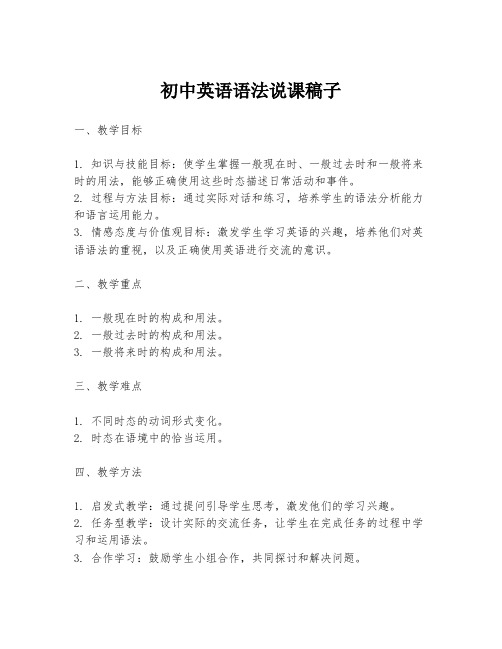
初中英语语法说课稿子一、教学目标1. 知识与技能目标:使学生掌握一般现在时、一般过去时和一般将来时的用法,能够正确使用这些时态描述日常活动和事件。
2. 过程与方法目标:通过实际对话和练习,培养学生的语法分析能力和语言运用能力。
3. 情感态度与价值观目标:激发学生学习英语的兴趣,培养他们对英语语法的重视,以及正确使用英语进行交流的意识。
二、教学重点1. 一般现在时的构成和用法。
2. 一般过去时的构成和用法。
3. 一般将来时的构成和用法。
三、教学难点1. 不同时态的动词形式变化。
2. 时态在语境中的恰当运用。
四、教学方法1. 启发式教学:通过提问引导学生思考,激发他们的学习兴趣。
2. 任务型教学:设计实际的交流任务,让学生在完成任务的过程中学习和运用语法。
3. 合作学习:鼓励学生小组合作,共同探讨和解决问题。
五、教学过程1. 导入(Lead-in):通过展示不同时间的活动图片,引出时态的概念。
2. 新课呈现(Presentation):逐一介绍三种时态的构成和基本用法。
3. 练习(Practice):设计填空、转换句型等练习,巩固学生对时态的理解。
4. 应用(Application):通过角色扮演、情景对话等活动,让学生实际运用所学时态。
5. 总结(Summary):回顾本课所学内容,强调时态的正确使用。
6. 作业(Homework):布置相关的语法练习和写作任务,加深学生对时态的掌握。
六、教学媒体与教具1. 多媒体课件:展示时态的构成和例句。
2. 黑板:用于板书重点内容和练习题。
3. 卡片:用于角色扮演和情景对话活动。
七、板书设计- 一般现在时:构成 + 用法 + 例句- 一般过去时:构成 + 用法 + 例句- 一般将来时:构成 + 用法 + 例句八、教学反思课后,教师应根据学生的表现和作业完成情况,反思教学方法和内容,不断调整和优化教学策略,以提高教学效果。
通过这份说课稿,教师可以系统地准备和实施英语语法教学,确保学生能够全面理解和掌握英语时态的相关知识。
初中英语全英说课稿(优秀5篇)
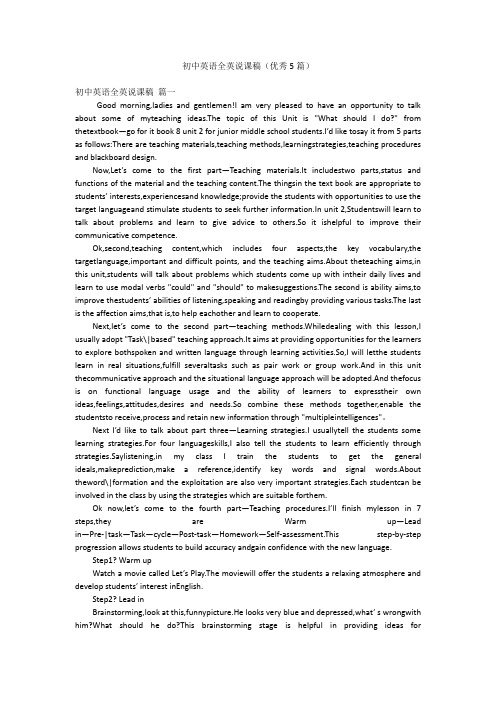
初中英语全英说课稿(优秀5篇)初中英语全英说课稿篇一Good morning,ladies and gentlemen!I am very pleased to have an opportunity to talk about some of myteaching ideas.The topic of this Unit is "What should I do?" from thetextbook—go for it book 8 unit 2 for junior middle school students.I’d like tosay it from 5 parts as follows:There are teaching materials,teaching methods,learningstrategies,teaching procedures and blackboard design.Now,Let’s come to the first part—Teaching materials.It includestwo parts,status and functions of the material and the teaching content.The thingsin the text book are appropriate to students’ interests,experiencesand knowledge;provide the students with opportunities to use the target languageand stimulate students to seek further information.In unit 2,Studentswill learn to talk about problems and learn to give advice to others.So it ishelpful to improve their communicative competence.Ok,second,teaching content,which includes four aspects,the key vocabulary,the targetlanguage,important and difficult points, and the teaching aims.About theteaching aims,in this unit,students will talk about problems which students come up with intheir daily lives and learn to use modal verbs "could" and "should" to makesuggestions.The second is ability aims,to improve thestudents’ abilities of listening,speaking and readingby providing various tasks.The last is the affection aims,that is,to help eachother and learn to cooperate.Next,let’s come to the second part—teaching methods.Whiledealing with this lesson,I usually adopt "Task\|based" teaching approach.It aims at providing opportunities for the learners to explore bothspoken and written language through learning activities.So,I will letthe students learn in real situations,fulfill severaltasks such as pair work or group work.And in this unit thecommunicative approach and the situational language approach will be adopted.And thefocus is on functional language usage and the ability of learners to expresstheir own ideas,feelings,attitudes,desires and needs.So combine these methods together,enable the studentsto receive,process and retain new information through "multipleintelligences"。
《语法》说课稿范文五篇
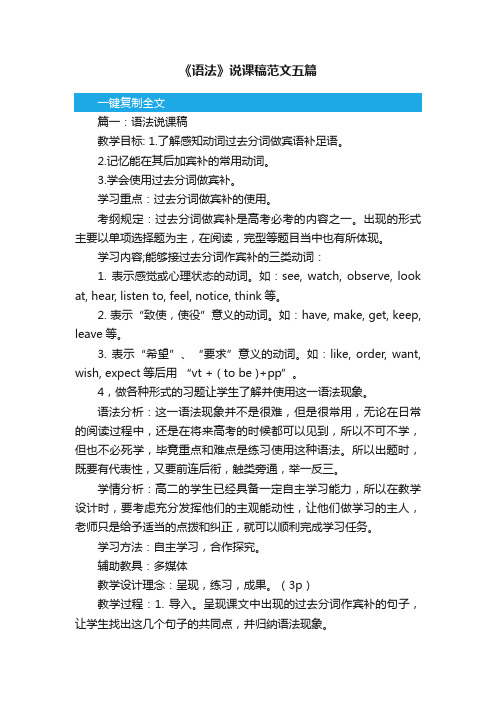
《语法》说课稿范文五篇篇一:语法说课稿教学目标: 1.了解感知动词过去分词做宾语补足语。
2.记忆能在其后加宾补的常用动词。
3.学会使用过去分词做宾补。
学习重点:过去分词做宾补的使用。
考纲规定:过去分词做宾补是高考必考的内容之一。
出现的形式主要以单项选择题为主,在阅读,完型等题目当中也有所体现。
学习内容;能够接过去分词作宾补的三类动词:1. 表示感觉或心理状态的动词。
如:see, watch, observe, look at, hear, listen to, feel, notice, think等。
2. 表示“致使,使役”意义的动词。
如:have, make, get, keep, leave等。
3. 表示“希望”、“要求”意义的动词。
如:like, order, want, wish, expect等后用“vt + ( to be )+pp”。
4,做各种形式的习题让学生了解并使用这一语法现象。
语法分析:这一语法现象并不是很难,但是很常用,无论在日常的阅读过程中,还是在将来高考的时候都可以见到,所以不可不学,但也不必死学,毕竟重点和难点是练习使用这种语法。
所以出题时,既要有代表性,又要前连后衔,触类旁通,举一反三。
学情分析:高二的学生已经具备一定自主学习能力,所以在教学设计时,要考虑充分发挥他们的主观能动性,让他们做学习的主人,老师只是给予适当的点拨和纠正,就可以顺利完成学习任务。
学习方法:自主学习,合作探究。
辅助教具:多媒体教学设计理念:呈现,练习,成果。
(3p)教学过程:1. 导入。
呈现课文中出现的过去分词作宾补的句子,让学生找出这几个句子的共同点,并归纳语法现象。
2. 过去分词作宾补表示的意义。
组织学生们自己读,自己记,同桌间互相检查,老师抽查。
3.习题练习:1)用所给单词的正确形式填空。
学生两人一组合作完成,各小组派一人起来说出答案。
2)单项选择题,共10个题。
学生四人一组,合作讨论,探究结果,展示汇报,学生评判,陈述理由。
初中英文说课稿
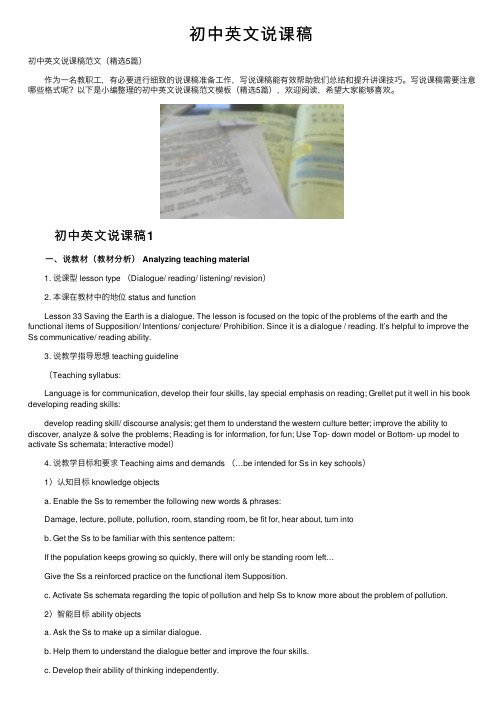
初中英⽂说课稿初中英⽂说课稿范⽂(精选5篇) 作为⼀名教职⼯,有必要进⾏细致的说课稿准备⼯作,写说课稿能有效帮助我们总结和提升讲课技巧。
写说课稿需要注意哪些格式呢?以下是⼩编整理的初中英⽂说课稿范⽂模板(精选5篇),欢迎阅读,希望⼤家能够喜欢。
初中英⽂说课稿1 ⼀、说教材(教材分析) Analyzing teaching material 1. 说课型 lesson type (Dialogue/ reading/ listening/ revision) 2. 本课在教材中的地位 status and function Lesson 33 Saving the Earth is a dialogue. The lesson is focused on the topic of the problems of the earth and the functional items of Supposition/ Intentions/ conjecture/ Prohibition. Since it is a dialogue / reading. It’s helpful to improve the Ss communicative/ reading ability. 3. 说教学指导思想 teaching guideline (Teaching syllabus: Language is for communication, develop their four skills, lay special emphasis on reading; Grellet put it well in his book developing reading skills: develop reading skill/ discourse analysis; get them to understand the western culture better; improve the ability to discover, analyze & solve the problems; Reading is for information, for fun; Use Top- down model or Bottom- up model to activate Ss schemata; Interactive model) 4. 说教学⽬标和要求 Teaching aims and demands (…be intended for Ss in key schools) 1)认知⽬标 knowledge objects a. Enable the Ss to remember the following new words & phrases: Damage, lecture, pollute, pollution, room, standing room, be fit for, hear about, turn into b. Get the Ss to be familiar with this sentence pattern: If the population keeps growing so quickly, there will only be standing room left… Give the Ss a reinforced practice on the functional item Supposition. c. Activate Ss schemata regarding the topic of pollution and help Ss to know more about the problem of pollution. 2)智能⽬标 ability objects a. Ask the Ss to make up a similar dialogue. b. Help them to understand the dialogue better and improve the four skills. c. Develop their ability of thinking independently. d. Cultivate their ability to discover, analyze and solve problems. e. Train them to collect information from the Internet. f. Train them with some effective learning methods to optimize Ss’ learning results. 3)德育⽬标 moral objects a. Arouse their interest in learning English; b. Help them to understand the background of pollution. c. Enable the students to love our earth and the nature. d. Be aware of the importance of stopping pollution & protecting our environment. e. Encourage the Ss to do something to save the earth. 5. 说教学重点 teaching important points (⽣词、句型;培养阅读技能) a. New words and phrases b. Sentence pattern: If- clause c. improve their reading skills. d. Talking about problems of the Earth. 6. 说教学难点 teaching difficult points (语法;发展交际能⼒) a. functional item: Supposition. b. Develop their communicative ability. Act out their own dialogue. 7. 说教具 teaching aids (multi-media computer, software, OHP) The teaching syllabus says that it’s necessary for teachers to use modern teaching facilities. It’s of great help to increase the class density and improve our teaching result. It can also make the Ss reach a better understanding of the text by making the classes lively and interesting. At the same time, it arouses the Ss’ interest in learning English. ⼆、说教法 Teaching methods Five step method; audio-video; communicative approach; Task-based learning: New Syllabus Design encourages teachers to use this teaching method. TBLT can stimulate Ss’ initiative in learning and develop their ability in language application. Make the Ss the real masters in class while the teacher himself acts as the director and bring their ability into full play. 三、说学法 Study methods 1. Teach Ss how to be successful language learners. 2. Teach Ss how to develop the reading skill — skim & scan; how to communicate with others; how to learn new words; how to learn independently; 3. Get the Ss to form good learning habits. 四、说教学过程Teaching procedures I. 复习(Revision) 5min (Daily report; 词汇diagram; brainstorming; activate schemata) Activity 1: Imagination 1) Suppose a bottle of ink is turned over and dirties your white shirt, what is to be done? (Wash it? Or throw it away?) 2) Suppose you catch a bad cold, what’s to be done? 3) Suppose your bike is broken, what’s to be done? 4) And suppose the earth, on which we all live, is damaged, what’s to be done? * What can you think of when you see "pollution" this word?(waste, environment, air, water, factory, desert, climate…Try to activate the Ss schemata regarding the topic of pollution.) II. 呈现(Presentation) 5min Activity 2: Presentation Play the song "Earth Song" sung by Michael Jackson. (Create an atmosphere) A lot of pictures and video clips about the causes and results of the three problems mentioned in this lesson will be shown on the screen with the help of the computer. Ss’ presentation on pollution. Attract their attention, arouse their interest, and create a good atmosphere for communication. * Activate their schemata and cultivate their ability in collecting information from the Internet and develop their ability in thinking independently. III. 对话 / 阅读(Dialogue)18m 1. Pre- reading Activity 3: Prediction 1st listening/ fast reading, one guided Q to help Ss to get the main idea: What do you think is discussed at the conference? 2. While- reading Activity 4: Read and answer 2nd listening/ careful reading, more Qs to get the detailed information. Develop their reading skills: skim & scan. Pay attention to the pronunciation, stress & intonation. * 阅读: Pre-reading; while-reading; post-reading (fast reading/ careful reading; skim/ scan; 识别关键词key words;确定主题句;创设信息差information gap;T or F; 填表格chart/diagram; Predicting; Make a timeline; Make a story map.达到对课⽂的`整体理解和掌握。
初中英语语法题说课稿

初中英语语法题说课稿尊敬的评委老师,各位同仁,大家好。
今天,我将就初中英语语法教学进行说课,主要围绕非谓语动词的用法进行讲解。
非谓语动词是英语语法中的一个重要概念,它包括动名词、不定式和分词。
非谓语动词在句子中可以充当除谓语以外的任何成分,如主语、宾语、表语等,其使用非常广泛。
一、动名词(Gerund)动名词是动词的一种非限定形式,通常以-ing结尾。
它可以作为名词使用,具有名词的所有功能。
例如:- Reading is a good habit.(阅读是一个好习惯。
)- I enjoy swimming.(我喜欢游泳。
)二、不定式(Infinitive)不定式是动词的一种基本形式,通常以to+动词原形构成。
不定式可以表示目的、原因、结果等,也可以作为名词、形容词或副词使用。
例如:- To learn English well is important.(学好英语很重要。
)- I want to visit the Great Wall.(我想去参观长城。
)三、分词(Participle)分词有两种形式:现在分词(Present Participle)和过去分词(Past Participle)。
现在分词以-ing结尾,过去分词通常以-ed结尾(对于规则动词)。
分词可以作为形容词使用,也可以构成进行时态和完成时态。
例如:- The running boy is my brother.(那个跑步的男孩是我的弟弟。
)- I have finished my homework.(我已经完成了我的作业。
)在教学过程中,我会通过以下几个步骤来引导学生掌握非谓语动词的用法:1. 引入概念:首先,我会向学生介绍非谓语动词的概念和分类,让学生对非谓语动词有一个基本的认识。
2. 举例说明:通过大量的例句,让学生了解非谓语动词在句子中的具体用法和作用。
3. 练习巩固:设计一些练习题,让学生在实际语境中运用非谓语动词,加深理解和记忆。
- 1、下载文档前请自行甄别文档内容的完整性,平台不提供额外的编辑、内容补充、找答案等附加服务。
- 2、"仅部分预览"的文档,不可在线预览部分如存在完整性等问题,可反馈申请退款(可完整预览的文档不适用该条件!)。
- 3、如文档侵犯您的权益,请联系客服反馈,我们会尽快为您处理(人工客服工作时间:9:00-18:30)。
Good afternoon, everyone. I’m Zhou Yan. I’m an English teacher from Experimental School of Suqian. Now I’ll say Sample A of Lesson Six in Book One. I’ll prepare to say the lesson from four parts.Part One Analysis of the Teaching Material(一) STATUS AND FUNCTION1.This is an important lesson in Book One. From this lesson, it starts asking the Ss to grasp contents of each Sample. To attain “four skills” request of listening, speaking, reading and writing. To start listing “Word Bank” and tell the Ss to re member the new words. To start asking the Ss to write English sentences well. Therefore this lesson is in the important position of the teaching material.2.This lesson is the first one of Unit 2.So if the Ss can learn it well, it will be helpful to make the Ss learn the rest of this unit.3.Such a topic is related to daily life, so it is helpful to raise learning interests of students and it will be also helpful to improve their spoken English.(二)ANALYSIS OF THE STUDENTSThe Ss has learned English for about one month so far. They can understand some words and some simple sentences. The Ss have takena great interest in English now.(三)TEACHING AIMS AND DEMANDSThe teaching aim's basis is established according to Junior School English syllabus' provision.1.Knowledge objects(1) To make the Ss know how to use the affirmative sentence “Thisis. . . .” and the negative sentence “This is not….”Everyday expressions for “Apologies”“I\'m sorry”“That\'s all right”.(2) To study the new words “six, hey, sorry, it’s, that’s”, etc. by learning the dialogue of this lesson.(3) To finish some exercises.2.Ability objects(1) To develop the Ss’ abilities of listening, speaking, reading and writing.(2) To train the Ss’ ability of working in pairs.(3) To dev elop the Ss’ abilities of communication by learning the useful structures.3.Moral objects(1) To enable the Ss to be polite and love life.(2) To enable the Ss to look after their things well.(四)TEACHING KEY AND DIFFICULT POINTSThe teaching key and difficult points’ basis is established according to Sample A of Lesson Six in the teaching material\'s position and function.1.Key points:(1).To help the Ss to communicate with each other.(2).To enable the Ss to study in groups and co-operate skillfully.(3).To develop the Ss’ interest in English.2.Difficult points:(1) How to make dialogues and act them out.(2) How to write the right whole sentences.(五) TEACHING AIDSMulti-media computer, Tape recorder, Software: Powerpoint or Authorware, school things and so on. They will be needed in this lesson. Part Two The Teaching Methods1. Communicative teaching method2. Audio-visual teaching method3. Task-based” teaching methodAs we all know: the main instructional aims of learning English in the Middle School is to cultivate students’ abilities of listening, speaking, reading, writing and their good sense of the English language. So in this lesson I’ll mainly use “Communicative” teaching method, “Audio-visual” teaching method and “Task-based” teaching method. That is to say, I’ll let the Ss to get a better understanding of the key structure of the dialogue. I’ll give the Ss some tasks and arrange five kinds of activities: talking, guessing games, watching CAI, acting out Sample A and having a competition.Teaching special featuresTo use these methods are helpful to develop the Ss’ thought.Part Three STUDYING WAYS1.Teach the Ss how to be successful language learners.2.Let the Ss pass \"Observation—Imitation—Practice \" to study language.3.Teach the Ss how to master dialogues and how to communicate with others.Teaching special features:Let the Ss communicate with each other and adopt competition methods to develop the Ss’ keen interest in English.Part Four Teaching ProcedureI’ll finish this lesson in four steps. First I’ll divide the Ss into four groups and bring a competition into the class. At last let’s see which group is the winner.Step1 Warm-up1. Free talk between T and Ss .Such as: Hi, I’m . . . . What’s your name?This is …. How do you do?Who is he/she? How are you?Who can count from 1to 5?What’s this in English? etc.2.A game: Ask the Ss to give T some school things. For example:T: Give me your book.(ruler, box, pen, table, knife, etc.)T: This is your bo ok. This is not my book. It’s your book. etc.In this course I’ll ask them to make a dialogue group by group without repetition. Find out which group will make the most dialogues.Purpose of my designing: I think it is important to form a better English learning surrounding for the Ss by imitating and at the same time it is necessary to provide situations to review learned knowledge.Step2. PresentationThis course is very important. I’ll mainly talk about this step.I’ll use CAI to present the whole d ialogue. Arrange some situations to help Ss understand Sample A.First scene: There is a bag on the floor. B is picking it up and get ready to leave. Now A is talking with B.A: Hi, B. How are you today?B: I’m fine, thank you. And you?A: I’m fine, to o. Oh, this is my bag.B: No, this is not your bag. It’s my bag.A: (Look closely) Oh, I’m sorry.B: That’s all right.(At the same time, C is running up and hitting A.)C: Oh, I’m sorry.A: That’s OK.I’ll write the key points on the Bb while they are watching. After watching, I’ll teach them to read the words and sentences on the Bb. Make sure they can read them well.Purpose of my designing: To present Sample A by CAI is much easier for the Ss to learn and grasp the meanings. CAI can provide a real situation with its sound and picture and it makes the relationships between the Ss better.Step3.PracticeFirst play the tape recorder. Let the Ss listen and imitate the dialogue. Pay attention to their pronunciation and intonation. In this step the Ss are required to practise the Sample in pairs by reading the dialogue aloud. This step is employed to make the Ss grasp the Sample .At last I’ll ask the Ss to think hard and act it out with a partner according to Sample A. Then find out which group will a ct it out well. I’ll give them red stars. Purpose of my designing: This step is employed to make the Ss get the general idea of the dialogue as a whole one. At the same time let the Ss have a chance to practise their listening and spoken ability.Step4.ProductionIn this step I’ll give the Ss a free space to show their abilities.Second scene: The Ss are having a picnic. It’s hot and they take off their coats and put them together. They are singing and dancing, laughing and chatting. After the picnic, they begin to look for their coats. D and E are talking. F and G are talking. etc.After watching, I’ll give the Ss some tasks to make similar dialogues without repetition and find out which group will make more dialogues. Purpose of my designing: “Task-b ased” teaching method is used here to develop the Ss’ ability of communication and also their ability ofco-operation will be well trained. Tell the Ss we should be polite and take good care of our things. We should love our life. I think proper competitio n can arouse the Ss’ interest in English learning. If the Ss can finish this task well, they will benefit a lot in their spoken English.2.Skill 1 Model 1.I’ll ask four Ss of the groups to write these sentences on the Bb in the four lines.Then check their handwriting, correct their mistakes. Find out who will write well and whose handing is the best.3.Finish the Ss’ workbook.Purpose of my designing: To check the knowledge Ss have learned in this lesson.Step5.Homework:(1)Recite the words as many as possible after class.(2)Make a dialogue according to Sample A and write it in the exercise book.Purpose of my designing: I think homework is so important that the Ss should speak English as much as they can in class or after class. It is necessary for the Ss to do some extensive exercises after class to consolidate the knowledge they learned.Blackboard DesignLesson Six Sample ASix This is my….hey This is not your. . . .sorry It’s my. . . . Picture it’s=it is Oh, I’m sorry.that’s=that is That’s a ll right/OK.《阿房宫赋》原文翻译对照杜牧(803-852),字牧之,唐朝万年人(今西安),晚唐杰出的诗人、文学家,人称“小杜”以别与杜甫。
